Steel is showing up more frequently on newly-constructed airport exteriors across the country and globally too. The trend signals a see-and-avoid juncture for airport construction specifying mindful that steel products are more appropriate for airport construction than others. Material selection is a decisive factor for the durability and life cycle of any infrastructural buildings and installations.
Steel usage definitely gives a high corrosion-resistant, coated, or uncoated stainless steel finish with low glare and a long lifecycle for the entire structure.
The characteristics of steel satisfy the needs of airport construction for light and economical structures that meet both safety and sustainability criteria. Where other architectural metals exhibit a limited life span, steel endures. Due to its relative inertness, steel is considered to be environmentally friendly. It is 100 percent recyclable and does not contaminate the environment.
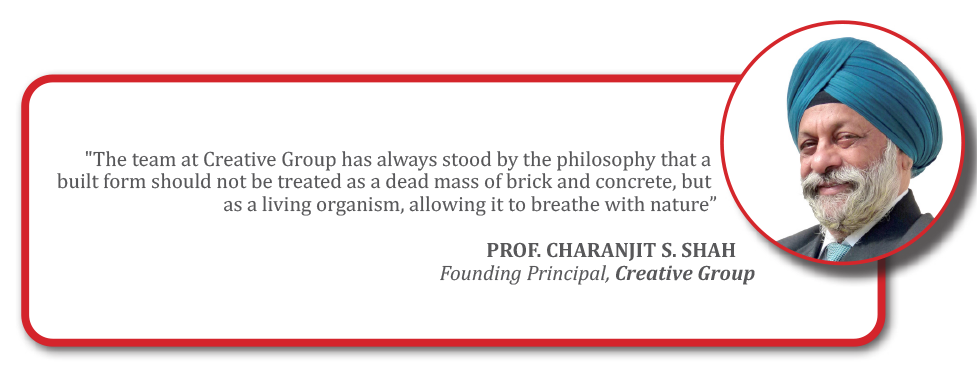
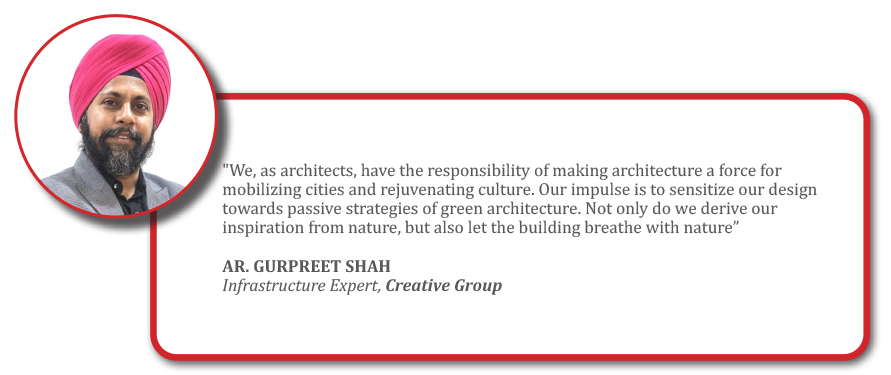
PROJECT BRIEF & BACKGROUND
One of the world’s most diverse nations has planned a gateway of 30,000 sq. ft. to enter its center of handicrafts; namely, the city of Rajkot. The Rajkot Airport is a magical amalgamation of the rich heritage of the historic city and contemporary architecture worth Rs. 353.66 crores.
Rajkot, like most of the cities in Gujarat, showcases a composition of architectural elements borrowed from different architectural styles, the focus elements being domes, arches, elaborate columns, shikharas, etc. It is a city where great musicians passed on their knowledge to the world and is famous for its exceptional pottery, tinted with hues of white and Persian blue.
CLIENT BRIEF
The brief was to implement the project of the New Greenfield Airport at Hirasar, Rajkot to tackle the booming crowd of people during the peak hours of travel.
INSPIRATION
Rajkot’s elegant palette of arts and craftsmanship is well-known and revered. From embroidery and block printing to jewellery design and metal crafts; there is not much that the local craftsman cannot do. This is a city that holds a niche of craftsmen who once catered to the royalties and now, in modern times, as the craft got handed down through generations, the new-age craftsmen are utilizing their skills to create metal and wood-carved small ornaments.
Home to many historical landmarks like Kaba Gandhi No Delo, Jubilee Garden, Watson Museum, etc. Despite the malls and business hotels springing up in Rajkot, it still feels like a gateway to the olden days. With a 4 century-long historical imprint, traditional values are upheld to their highest form.
After a lot of deliberated observation and continuous brainstorming, we picked elements of the local architectural context. Rajkot flaunts a wide range of arches and jali works. Semi-circular and pointed arches along with ornamentation of GFRC jali work have been provided as a façade skin to limit the heat gain within the building. This type of intricate jali work also makes way for beautiful light and shadow theatrics. Most of the planning has been conducted by keeping straight line flows and an intuitive way of finding on top of the head. With the traditional elements working as the center-piece gem laid on a contemporary form necklace, this airport is a jewel that will make the city of Rajkot shine.
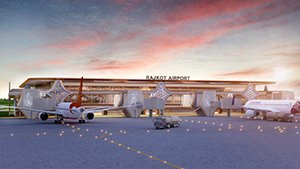

CHALLENGES
While designing an airport, architects do face a lot of challenges, from making it a global facility to managing such large public spaces or, creating an aesthetically pleasant structure including commercial and financial feasibility; it is a feat.
The brainstorming sessions during the design process mainly involved discussions on minimizing heat gain of the building, retention of the dynamism in façade form, spatial constraints in planning and blending the local ancestral heritage with a modern contemporary design. The team faced a lot of challenges in order to fulfill the desired requirements. With numerous transformation and modification stages, the team turned all the challenges in their favor and drew up the blueprints of a great structure that compliments the past, present and future of the city.
The usual design philosophy for the team is to create a loud and parametric roof that dominates the structure, however, by keeping a simplistic roof, the team has zealously attempted to retain the dynamism in the façade format. The GFRC jalis and canopies extended all the way to the roads are the team’s endeavors to cut down internal heat gain. Planning a ‘straight line’ flows and processes wherever possible, opportunities for intuitive wayfinding and the ability to expand the terminal and processing areas to east and west without loss of significant assets, was another obstacle for the team which they conquered successfully.
HARMONY
The interior of a structure is as important as the exterior, be it for functional needs or aesthetic purposes. Each individual space in the airport has been bejeweled with paintings and installations derived from the local heritage.
Repetitive patterns inspired by the stairs of a Gujarati Baoli have been used as artwork at the check-in area. Red Mata Ni Pachedi oil paintings and lion safari paintings have been done in the baggage claim area. Colorful Pithora paintings in the security hold area, umbrella installations on the ceiling of the security hold area of the first level, recycled metal dandiya, terracotta boat and bowl, a swing and a terracotta horse and trumpet installations have been done at varied locations of the airport.
IN CONCLUSION
The patience and dedication brought the team into balancing between heritage and contemporary architecture. The team did their best to pay homage to the glorious art and architecture of Rajkot along with the modern world technology, functionality and user experience.
The Rajkot Airport is truly being designed as the dream of millions of passengers traveling to the city of art and crafts by creating a modern structure and yet, not forgetting to honor the great cultural heritage of Rajkot city. We are going to make the airport itself a gateway to the journey of old times and give the users a chance to relive the old world with modern tiles under their feet.
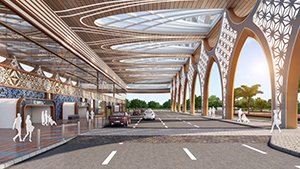
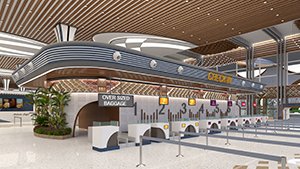
- UPCOMING AIRPORTS IN INDIA
Sriperumbudur Airport, Chennai, Tamil Nadu
New Vijayawada Airport, Vijayawada, Andhra Pradesh
Jewar Airport
Noida, Delhi
Purandar Airport,
Pune, Maharashtra
Vijayapura Airport, Vijaypura, Karnataka
Kalaburagi Airport, Kalaburagi, Karnataka,
Dabra Airport, Gwalior, Madhya Pradesh
Dholera International Airport, Dholera, Ahmedabad, Gujarat
Dagadarthi Airport, Nellore, Andhra Pradesh
Bhogapuram Airport, Vizianagaram
Andhra Pradesh
Pakyong Airport, Gangtok, Sikkim.





